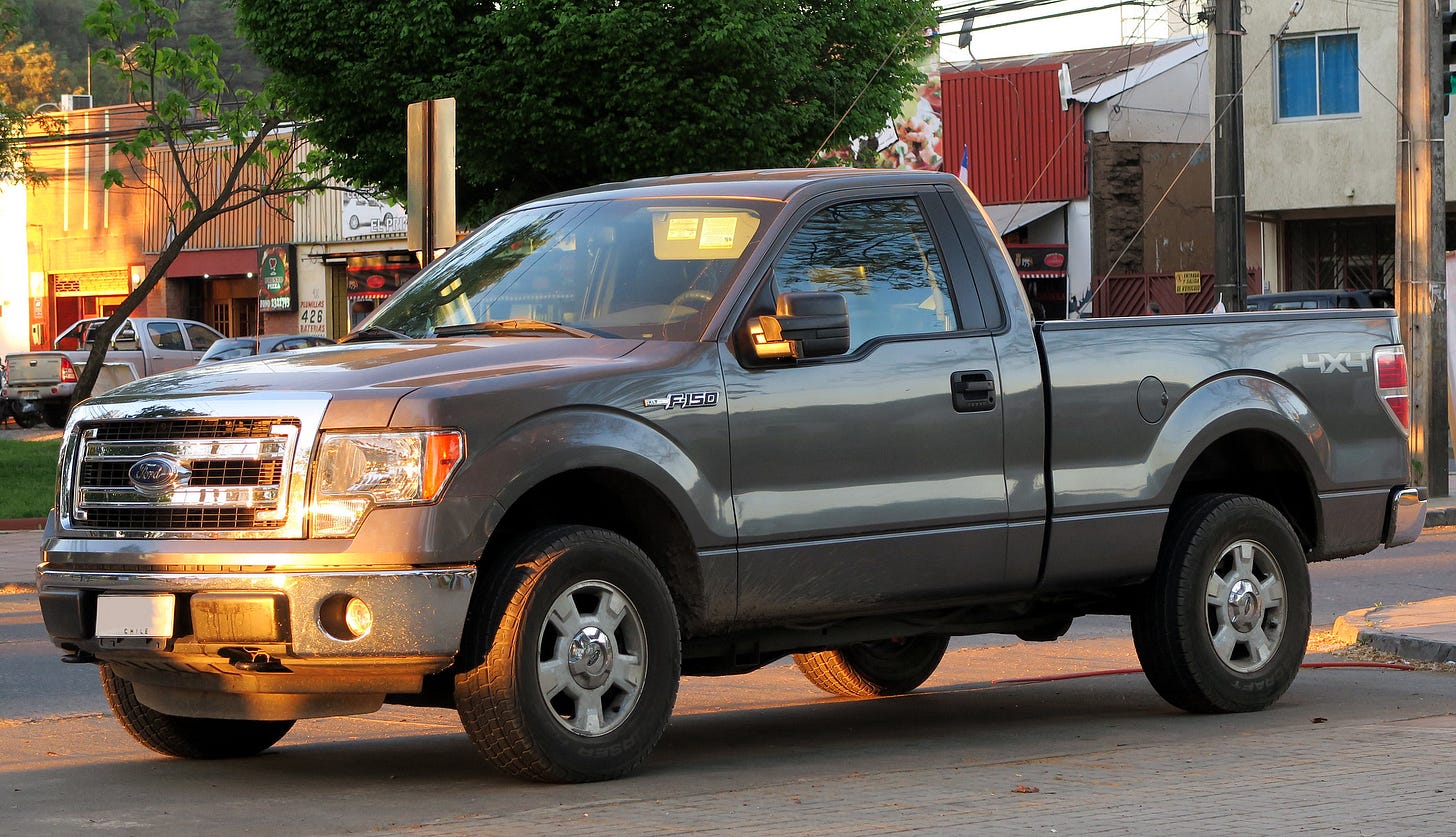
While researching for my last post on congestion pricing, I came across an interesting policy in Milan. Like New York City, Milan has a congestion pricing zone, which charges vehicles to enter parts of the city during peak hours. But unlike the Big Apple, Milan’s zone differentiates passenger vehicles, restricting larger, more polluting vehicles from entering certain zones.
This makes sense as larger vehicles cause more harm to a city than smaller ones, in the form of more pollution, traffic, infrastructure wear and tear, and, most importantly, danger to everyone not in a large vehicle.
Milan is the exception to an unfortunate reality: Owners of big trucks and SUVs rarely, if ever, pay the real costs of their supersized vehicles. And such an oversight has deadly consequences for both pedestrians and the Planet.
For years, automakers have cranked out bigger vehicles (that bring back bigger profits), marketing them as rugged, powerful, masculine, and even safer than their sedan counterparts. The strategy worked: 80% of new American cars are SUVs or trucks (up from 50% 10 years ago), and the average new American car weighs around 30% more than it did 40 years ago.
But as these cars got bigger, so did their impacts on pedestrians:
Between 2014 and 2024, U.S. pedestrian deaths rose at a rate almost seven times faster than population growth.
Children are eight times more likely to die when struck by an SUV compared to children struck by a smaller car.
Cyclist injuries, especially head injuries, are more severe when struck by an SUV compared to a car.
And, of course, bigger vehicles are also terrible for the Planet:
Heavier vehicles burn through gasoline much faster than smaller cars, which increases their carbon emissions.
Heavier vehicles also degrade roads and tear through tires faster, shedding microplastics that pollute the environment.
This inevitably brings up a problem with electric vehicles — a topic I’ve wrestled with many times before — as electric SUVs now make up at least 60% of EV options in China, Europe, and the U.S.
Though EVs don’t emit pollution from their tailpipes, large EVs still come with many of the same societal costs as gas-powered trucks — sometimes more so, as massive batteries are often much heavier than the engines they replace.
And like larger gas-powered vehicles, electric SUVs and pickup trucks need more energy, which means more electricity and therefore more carbon emissions: Some big electric models even generate more emissions than smaller gas-powered cars.
Perhaps most importantly, if you get hit by a huge truck, it doesn’t matter if it's powered by gas or electricity — you’re still more likely to die than if you get hit by a smaller car.
This isn’t to say we shouldn’t invest in EVs. But it should remind us that EVs are not a silver bullet to our transportation problem. And that all big cars, regardless of what they run on, should reflect the costs they put on society.
For ideas on how to do this, we can look to cities and countries around the world:
France and Norway, for example, charge thousands of dollars to register the heaviest cars (EVs are exempt in France, but not in Norway).
Washington, D.C., and Hawaii require car owners to pay several hundred dollars to register heavier vehicles; Colorado and California have proposed similar fees.
Paris and Montreal make owners of heavier cars pay way more to park (and Paris is now trying to ban SUVs altogether).
Funds raised through these fees can go toward pedestrian safety initiatives and safer, cleaner options like public transit — much like how New York City is using congestion pricing tolls to upgrade its subway system. And just as importantly, by bearing these true costs, truck owners may decide to become car owners instead.
This won’t be easy. For years, automakers have spent billions of dollars advertising bigger cars. Taxing the size of vehicles threatens these automakers, many of whom are now all in on SUVs. And because so many people love and own big cars, we can expect a lot of pushback from consumers, too.
So what messengers can do is focus on the facts: U.S. pedestrian deaths continue to rise, while such deaths in other countries fall. And the one huge culprit is the behemoths we continue to make, buy, and drive.
By asking owners of the biggest, heaviest, and most dangerous cars to pay the true cost of their impacts, we can create safer and greener communities.




Hi Brandon - thanks for sharing what anyone on foot in the US knows is a huge problem. My family members often walk or cycle for errands, commuting or just for fun. Like many folks on foot, we’ve noticed a trend towards more massive vehicles - taller hoods in particular that make it more difficult for drivers to see pedestrians in front and to the sides. The stats you point out make the impacts clear. Not the progress we need to make towards Vision Zero.
I’m curious if you’ve heard of the proposed NHTSA rule for reducing head impacts on pedestrians. Public comment opened last fall, but I didn’t see any press locally. Officially the comment period is over, but surprisingly in this regime, the website is still accepting inputs. https://www.federalregister.gov/documents/2024/09/19/2024-20653/federal-motor-vehicle-safety-standards-pedestrian-head-protection-global-technical-regulation-no-9
There’s also a UN body that harmonizes vehicle regs (of course the US isn’t part of it) which is mandating more pedestrian safety features. The EU also has implemented new rules on driver visibility for commercial trucks that goes into effect next year. https://www.transportenvironment.org/articles/a-new-law-reduces-truck-blindspots-e-truck-designs-can-finish-the-job
And somehow the best we can do here in the states is mandate that WHEN pedestrians ARE struck, the hood does less damage? Seems crazy to me that we’re not demanding tougher standards for driver visibility in addition to making the streets themselves safer for pedestrians and cyclists.